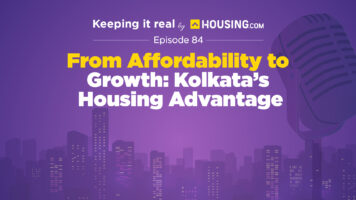Property purchase is one of the major financial goals for most people. The decision is backed by careful consideration of several factors, and the right location is one of them. A homebuyer is often faced with two location choices – the city or the suburb. With limited land availability and skyrocketing property prices in the city centre, the focus has shifted to the outskirts where most real estate developments are happening. Owning a home close to the main city has its advantages. Suburbs see a steady rise in property demand and rapid development of infrastructure, ensuring a convenient lifestyle for potential buyers. The returns from a property investment are influenced by the location, among other factors. Besides city suburbs, tier-2 cities also bring plenty of investment opportunities for property buyers. Some tier-2 cities, such as Lucknow and Jaipur, are outpacing city suburbs in terms of real estate growth and price appreciation. In this guide, we will bring a quick comparison between the real estate markets of metropolitan suburbs and tier-2 cities. The comparison will help end-users and property investors make an informed decision.
Tier-1 suburb real estate overview
Metropolitans and other major cities have growing suburbs owing to the burgeoning population. These top cities, including Delhi, Mumbai and Bangalore, are urban centres with thriving economies, robust infrastructure and ample employment opportunities. As urbanisation takes place and city centres become saturated, real estate demand shifts to the surrounding regions, leading to the growth of suburbs.
In recent years, the real estate industry in the suburbs of major cities has seen tremendous growth. The demand for earlier was limited to affordable housing. However, the luxury property segment is gradually picking up. The proximity to the main city is an appealing factor that benefits homebuyers. Moreover, advanced infrastructure and connectivity, especially through Metro Rail and arterial roads, have made accessibility to the main city faster, enabling people to commute to workplaces. The proximity to central business districts of the main city gives an edge to these city suburbs, unlike other tier-2 cities. City suburbs are expected to see continued growth in the coming years, backed by increased economic activities, infrastructure upgrades and government initiatives.
Some emerging micro-markets in top cities include Gurgaon, Dwarka Expressway and Greater Noida West (Noida Extension) in the National Capital Region (NCR), Thane and Navi Mumbai near Mumbai Metropolitan Region (MMR), Whitefield (near Bangalore) and Hinjewadi near Pune.
Tier-2 cities real estate overview
While tier-2 cities differ from metro cities in terms of population size and other factors, some of these cities are rapidly growing and emerging as preferred real estate destinations. Owing to rapid urbanisation driven by population growth in major cities and migration of people in search of jobs, the property demand started picking up in tier-2 cities in the past few years. The COVID-19 pandemic accelerated this shift as homebuyers started looking to these cities for property buying. Many of these smaller cities, such as Jaipur, Lucknow and Kochi, attract numerous start-ups and large companies and some reputed educational institutions. The influx of working professionals and students to these cities drives the demand for homes – both for buying and renting.
Real estate market in tier-2 regions is characterised by lower land prices. Affordability is a major factor that appeals to prospective homebuyers. On the other hand, city suburbs see large-scale real estate activities due to huge property demand and prices are steadily increasing.
Like the city suburbs, many tier-2 and smaller cities, such as Coimbatore and Ahmedabad, are undergoing infrastructure upgrades like Airport expansion and Metro Rail projects. Hence, the market is favourable for property investments because prices will continue to appreciate in the coming years.
Property rates in tier-1 suburb vs Tier-2 cities
When compared to the top metros, property rates in both suburban areas and other tier-2 cities are relatively lower. The property rates are generally lower in tier-2 cities. However, with continuous infrastructure development, the prices tend to see gradual appreciation, resulting in potentially higher returns for buyers. On the other hand, metro suburbs strike a balance between the two extremes – saturated markets of the main cities and the emerging markets of the tier-2 cities. The prices may depend on various factors, especially the location and demand. Some suburban areas of major metropolitans are expensive than prime neighbourhoods of smaller tier-2 cities.
Property rates in metro suburbs
| City | Average property price (in Rs per sqft) | Average monthly rentals |
| Dwarka Expressway (NCR) | Rs 12,400 | Rs 30,000 |
| Greater Noida West (NCR) | Rs 6,647 | Rs 22,000 |
| Thane West (MMR) | Rs 15,200 | Rs 35,000 |
| Navi Mumbai (MMR) | Rs 10,500 | Rs 40,000 |
| Old Mahabalipuram Road (OMR) (Chennai) | Rs 5,900 | Rs 12,000 |
| Hinjewadi (Pune) | Rs 8,700 | Rs 30,000 |
| Whitefield (Bangalore) | Rs 12,000 | Rs 40,000 |
Property rates in tier-2 cities
| City | Average property price (in Rs per sqft) | Average monthly rentals |
| Bhopal | Rs 4,500 | Rs 15,000 |
| Chandigarh | Rs 20,000 | Rs 44,000 |
| Coimbatore | Rs 5,800 | Rs 15,500 |
| Jaipur | Rs 5,540 | Rs 20,000 |
| Kochi | Rs 6,800 | Rs 30,000 |
| Lucknow | Rs 5,400 | Rs 14,000 |
| Nagpur | Rs 5,200 | Rs 20,600 |
| Nashik | Rs 4,600 | Rs 18,000 |
Investment potential and future appreciation
Many tier-2 cities are recording double-digit growth in real estate prices and even see a rising demand for premium homes. Some of these cities are catching up with bigger cities and show huge potential for price appreciation. On the other hand, the suburbs of top cities offer high potential for good returns; property appreciation may be a slow but gradual process, depending on several factors. Nevertheless, both suburbs and tier-2 cities have a huge potential for future development, with new roads, flyovers, metro expansion and real estate developments.
Housing.com News Viewpoint
The emerging real estate hotspots in city suburbs and tier-2 cities reflect the growing trend of urbanisation. Key factors such as a booming job market, infrastructure development and evolving lifestyle needs of homebuyers influence this change and property demand in a region. When choosing between a city suburb and a tier-2 city, potential homebuyers should evaluate their needs carefully. Homebuyers and other end-users must consider their budget, family needs and lifestyle choices and proximity to workplaces before finalising a property. Staying close to the main city does offer many advantages to the buyer, especially access to the office hubs and potential employment opportunities. For potential investors, it is crucial to study the market trends and prospects to ensure they get a high ROI and rental returns.
FAQs
What factors to consider when choosing between city suburbs and tier-2 cities?
Homebuyers should consider factors such as availability of social infrastructure, proximity to workplace or office hubs, family’s housing needs, future price appreciation, etc.
Are tier-2 cities good for long-term property investment?
Yes. Property investment in a tier-2 city can be beneficial over the long run as the prices tend to appreciate due to factors like fast-developing infrastructure.
| Got any questions or point of view on our article? We would love to hear from you. Write to our Editor-in-Chief Jhumur Ghosh at jhumur.ghosh1@housing.com |






